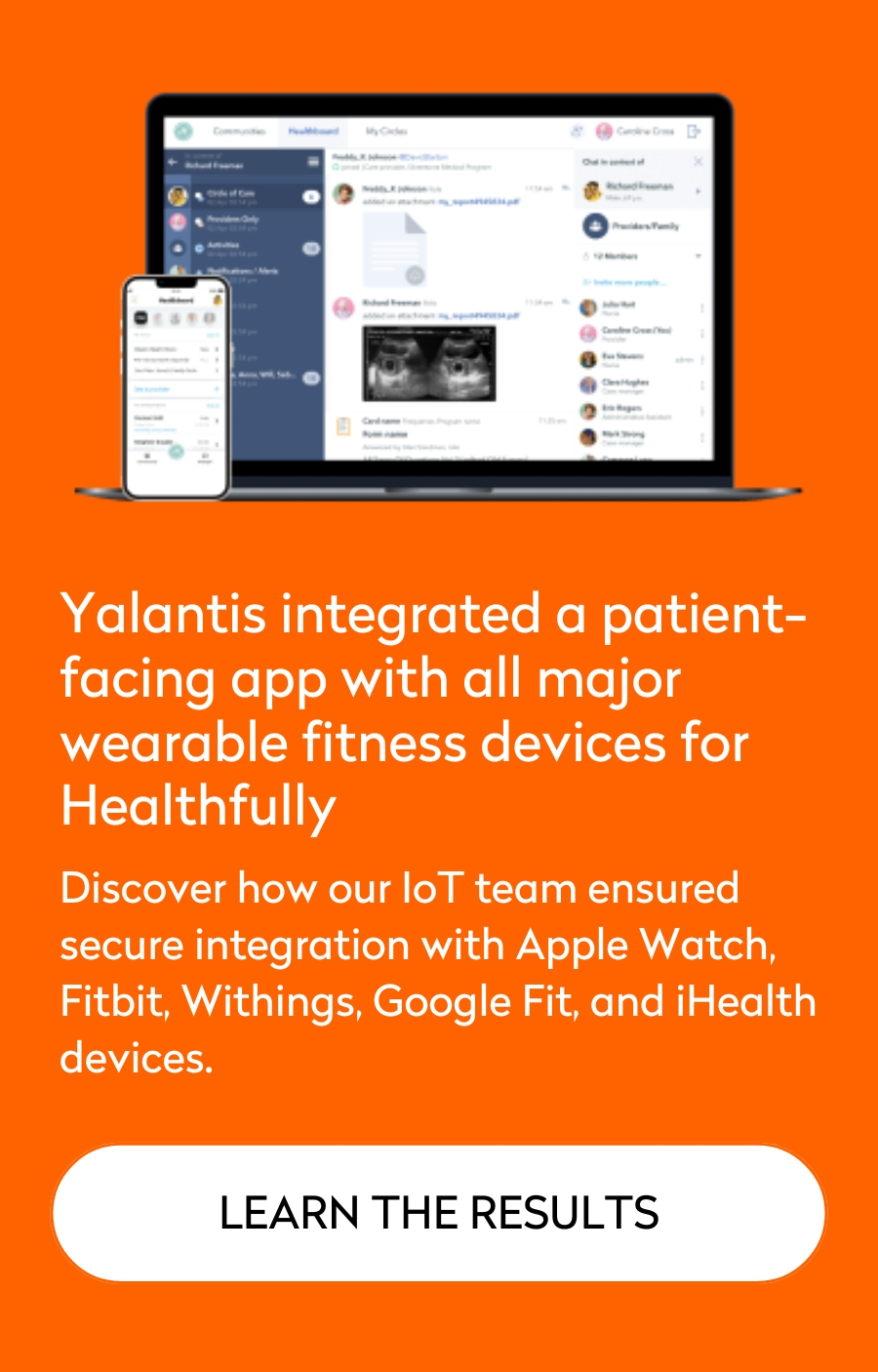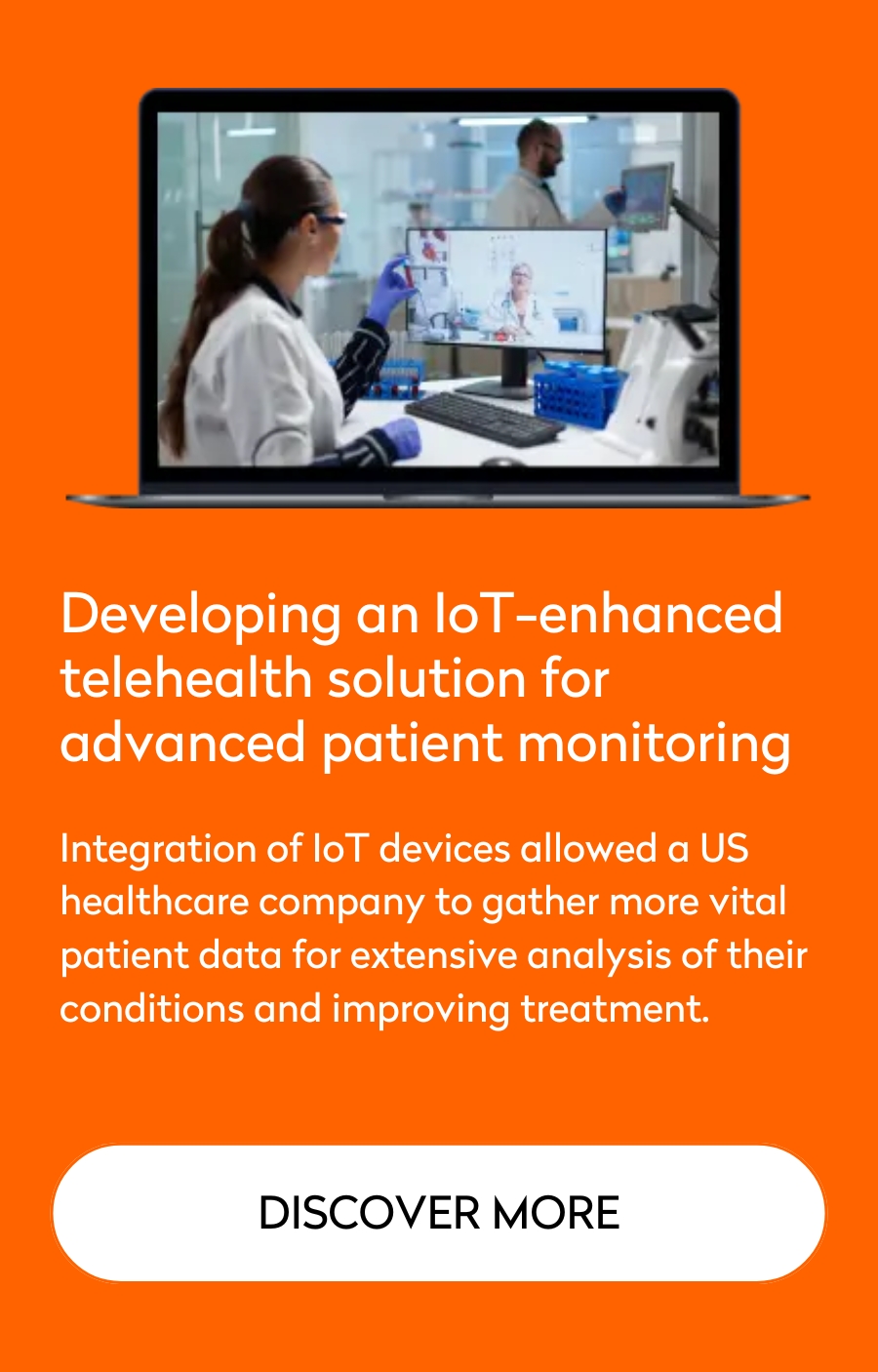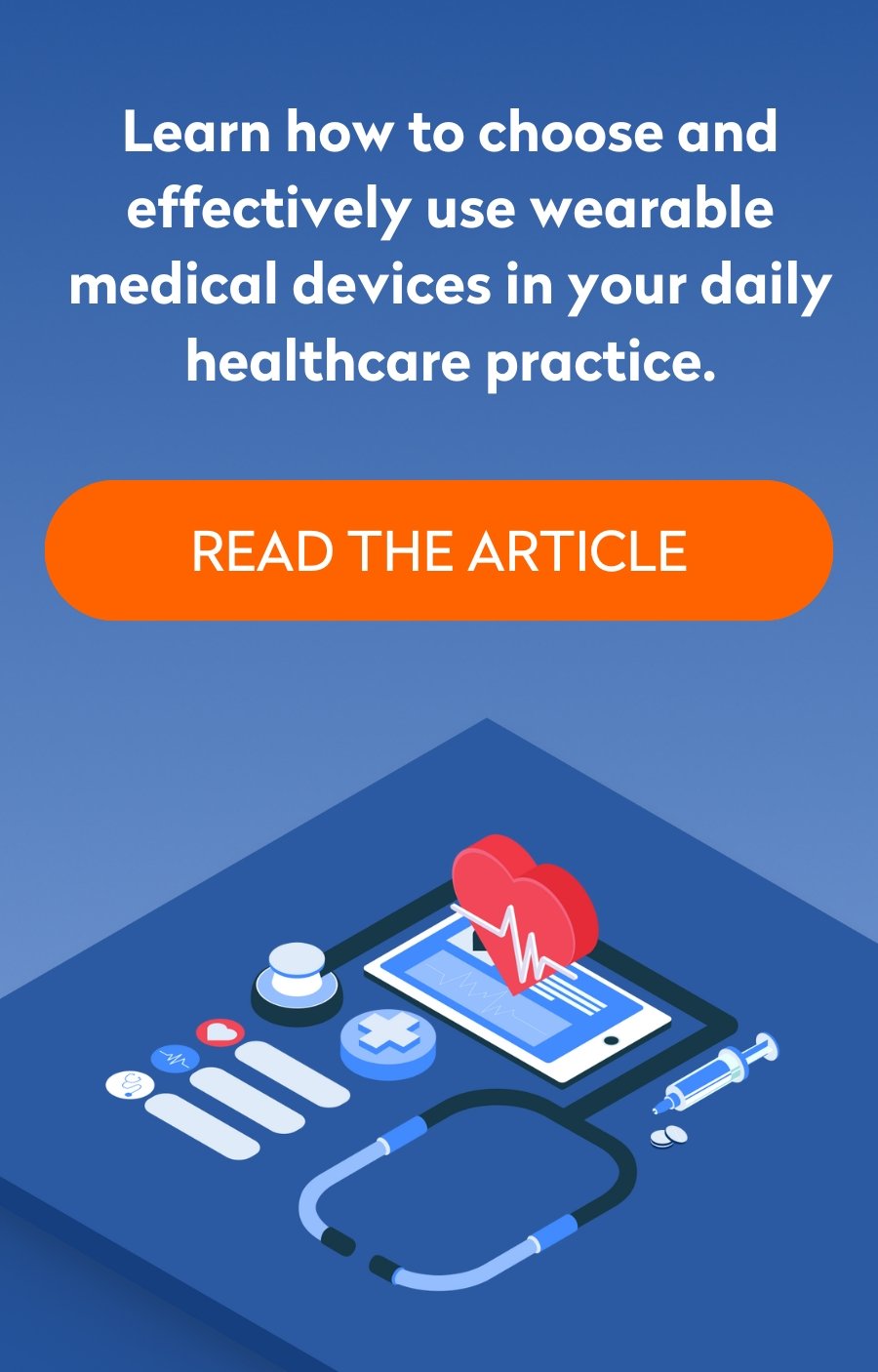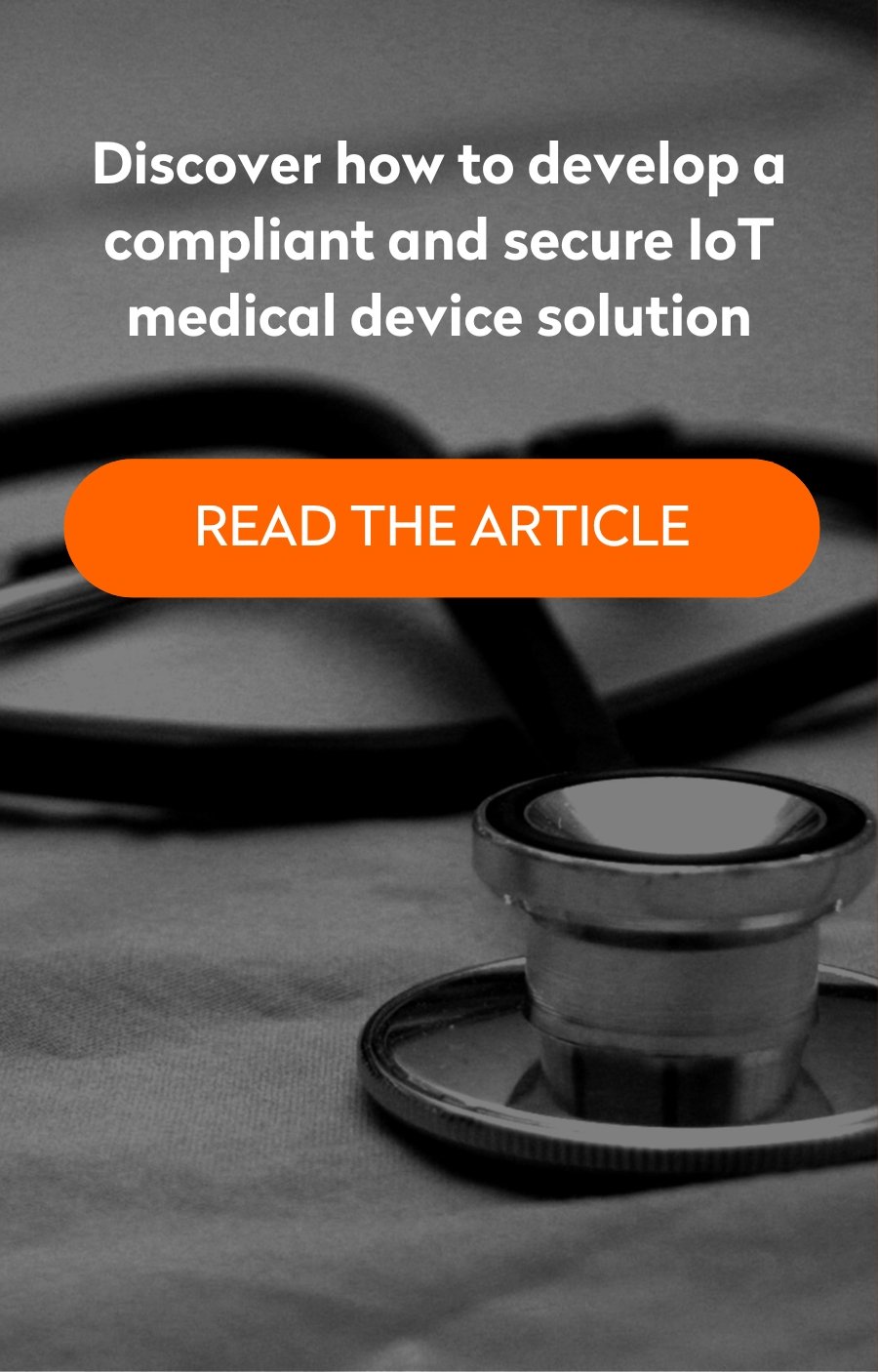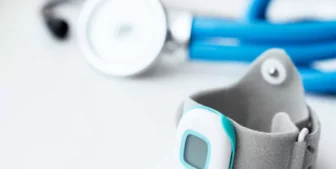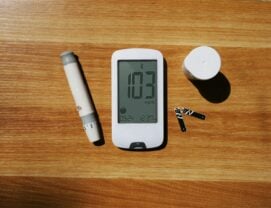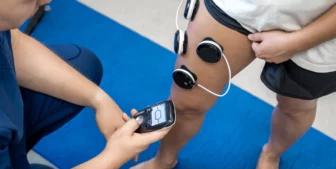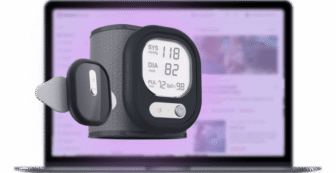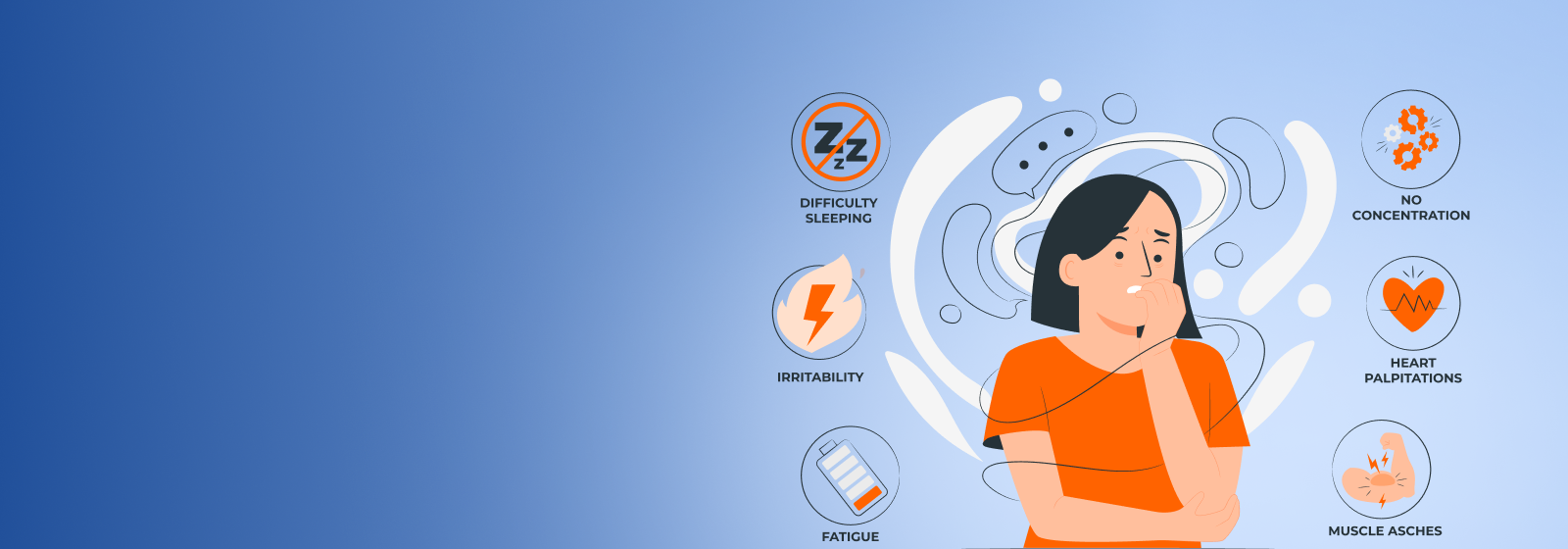
How Medical IoT Transforms Chronic Disease Management
Summarize:
Chronic disease management is one of the most resource-intensive areas of healthcare services, requiring continuous monitoring, frequent treatment updates, and proactive risk management. With growing pressure on clinical staff and resources, modern technologies like the medical Internet of Things (IoT) are proving effective in alleviating these burdens.
By integrating medical IoT, clinics can enhance patient care and improve operational efficiency through:
- Real-time remote chronic disease monitoring with IoT of both physical and mental health
- Personalized, timely interventions based on accurate data
- 24/7 access to support and care without overwhelming hospital staff
- Predictive insights into disease progression and treatment effectiveness
Current state of chronic illness management or why traditional patient monitoring methods aren’t enough
Disclaimer: This section isn’t diminishing the importance of traditional care, there is no debate that each patient with a chronic disease needs to take prescribed medications and undergo all-around health examinations. We aim to indicate the areas for improvement in traditional chronic disease management and treatment as well as to emphasize personalized care services.
According to the Centers for Disease Control and Prevention (CDC), 90 percent of all $4.5 trillion annual health care costs in the US are allocated to improving a chronic disease management model and treatment programs. This indicates that Americans suffer from chronic diseases more than from any other condition, influenced by many factors such as lifestyle, daily habits, environment, and sometimes unknown causes. While traditional care helps chronic disease patients maintain a stable quality of life, it often falls short of providing all-around patient monitoring and puts additional strain on hospital staff. Below are a few aspects that indicate that traditional chronic disease management isn’t that effective anymore and it needs innovative technological solutions and approaches.
4 reasons why traditional chronic disease management system needs improvement and how medical IoT can help
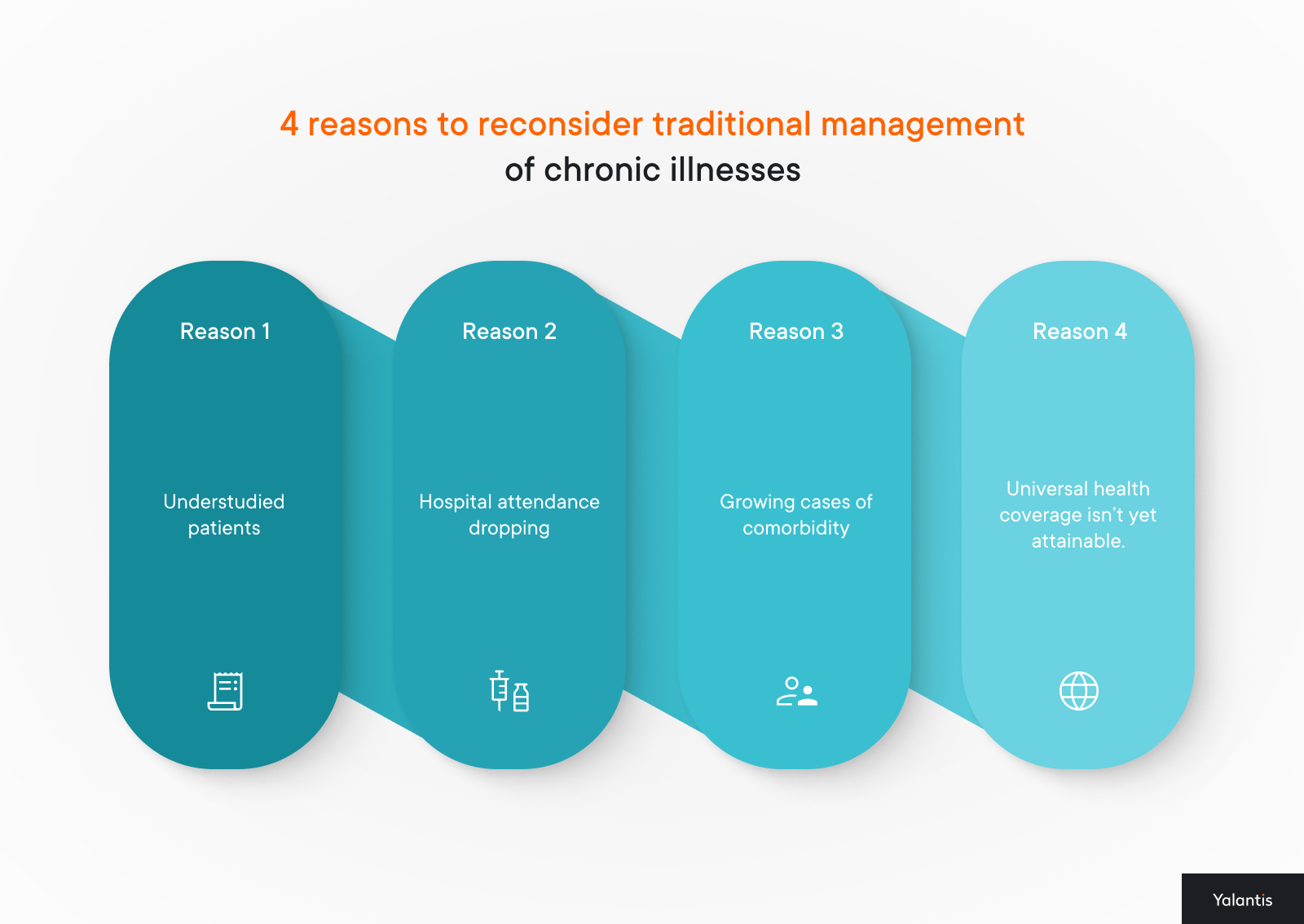
#1. Understudied patients. Healthcare facilities have established a time-tested approach to preventing, detecting, treating, managing, and monitoring chronic diseases. But does it prove effective all the time? The second report on the structured chronic disease management treatment program has revealed that among 21,328 patients diagnosed with heart failure, only 22.3 percent had an echocardiogram recorded. The reasons for this situation are different, some patients couldn’t or didn’t want to visit the hospital for this procedure, and not all general practitioners (GPs) had access to timely echocardiography services.
How IoT can help: Adopting IoT technology such as medical and non-medical devices could be a possibility for healthcare practitioners to improve patient care and their outcomes by ensuring regular all-around testing of their vitals.
#2. Hospital attendance is dropping. Attending hospitals on a regular basis is getting overwhelming. The same report we’ve mentioned above shows that only nine percent of the total number of chronic disease patients participating in the program (186,210) have regularly attended the hospital for health checkups.
How IoT can help: Although it’s crucial to encourage patients to visit hospitals, for instance, to take laboratory tests, IoT-driven remote patient monitoring can be a true game-changer for home-based chronic care management, providing medical professionals with timely access to vital patient data. Medical IoT allows chronic disease patients and healthcare practitioners to depend less on in-patient care, and hospital examinations.
#3. Growing comorbidity puts additional strain on the healthcare sector. It’s often the case for patients with one chronic condition to have a few others. For instance, diabetes can also cause stroke and other heart diseases which can result in extra health risks for the patient. Multimorbidity is a growing issue worldwide which puts additional responsibility on healthcare providers. Plus, it gets impossible for a single GP to treat several health issues and a patient requires specialized treatment from other clinicians as well.
How IoT can help: All specialists need to be equally in the loop regarding their patients’ conditions without the need for the patients to visit two or three different doctors every time they have an issue. Implementing IoT is a way to gather a patient’s vitals via a small sensor and transmit that data to safe consolidated storage accessible to authorized clinicians, a patient, and a patient’s relatives. Such an approach helps to keep everyone taking part in the patient’s treatment updated on their current condition. Chronic disease management technology means less frustration and burden for clinicians and disease management programs when managing lots of high-risk patients.
#4. Universal health coverage isn’t yet attainable. Ensuring higher inclusivity and accessibility of chronic care management is one of the goals of any healthcare organization. For instance, chronic disease patients who live in rural areas may not get the same quality healthcare services as people living in the city.
How IoT can help: IoT sensors and devices are accessible to everyone, this aspect is especially beneficial for people living in remote or rural areas without the possibility of regularly visiting hospitals or taking part in chronic disease management programs. Using IoT services, hospitals can provide personalized care for patients living in different areas. Thus, they can help more chronic disease patients without the risk of overwhelming medical staff with increasing hospital visits.
IoT technology has the power to diversify traditional chronic disease management services, increase their accessibility, and deepen understanding of different chronic conditions. A medical IoT solution provider can be a single device integrated with your electronic health record (EHR) system to track a patient’s health status. Or it can be a whole range of medical and non-medical devices connected into a complex network that sends data to diverse healthcare systems or custom chronic disease management software that allows healthcare providers to analyze patient data on a large scale to modify treatment programs.
With this in mind, let’s explore some common chronic conditions and the IoT devices that can support IoT for remote chronic disease monitoring and treatment during disease management programs.
Ready-to-go IoT chronic disease management solution is coming soon. Be among the first to try its powers.
Request more informationTraditional and IoT-based chronic disease management examples for common chronic diseases

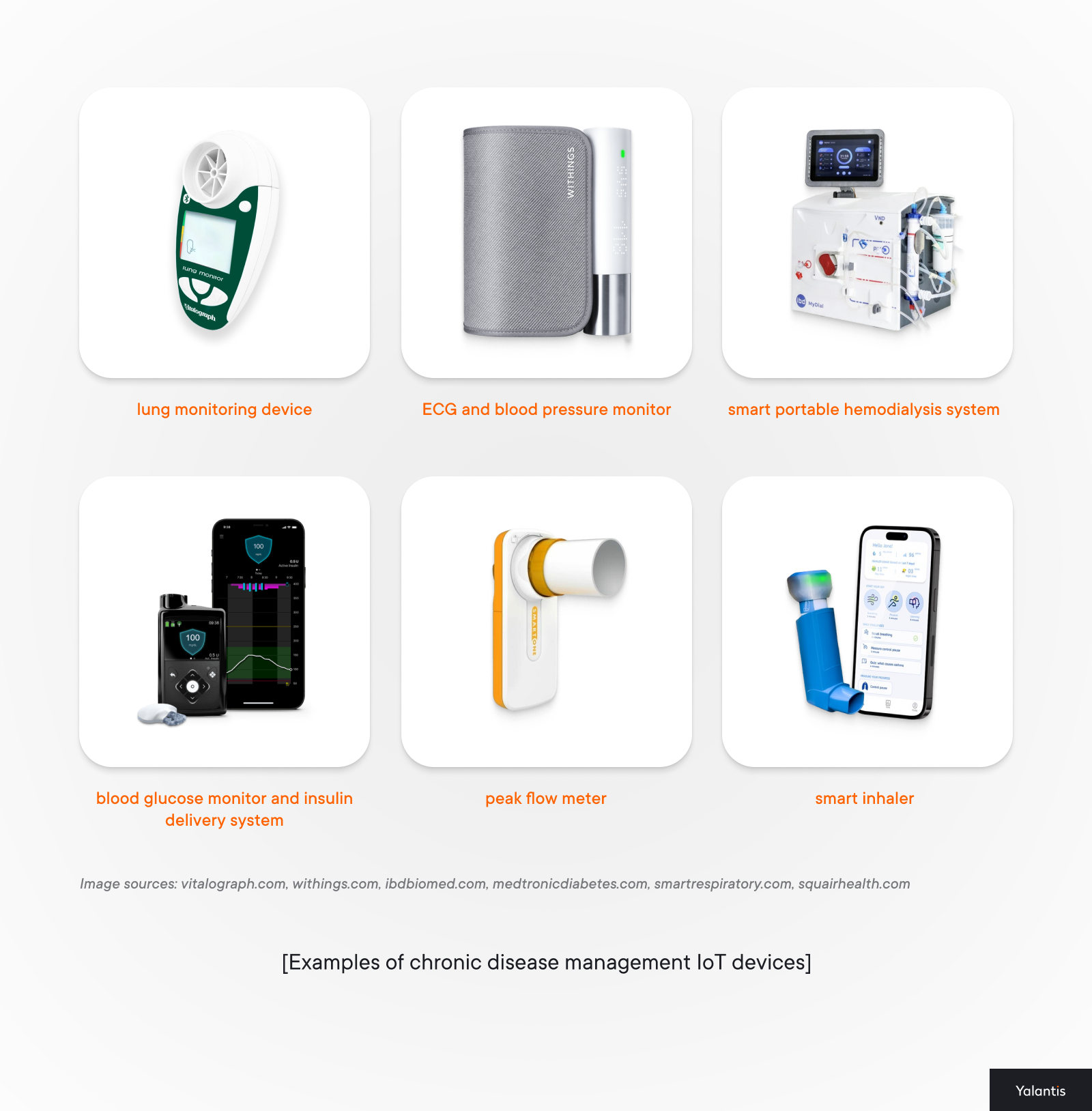
Planning to develop IoT devices for chronic care?
Get ISO 13485 & FDA compliance guidance.
Each patient with a specific chronic disease who takes part in chronic disease management with IoT programs can get an IoT healthcare solution that helps to monitor their current state to adjust care and medication intake, and timely inform clinicians of their condition. Such awareness reduces anxiety and allows patients to lead a more independent lifestyle without relying too much on healthcare practitioners.
Plus, each chronic condition has its complications and risks and if not properly diagnosed, treated, and monitored consequences can be life-threatening for a patient. In this case, IoT can be a life-saving tool that can continuously track and update patient data.
How Yalantis can help with devising an improved chronic disease management model with the help of IoT
IoT healthcare solutions for chronic disease management are only part of a large IoT ecosystem you can compose to improve remote patient monitoring of chronic disease patients. You can integrate these devices with your internal patient monitoring systems, EHR systems, health information systems, or any other system that your organization uses to gather comprehensive information about chronic disease patients. And Yalantis can become your trusted guide in establishing the IoT ecosystem.
What can you count on when working with our IoT experts?
In-depth research of suitable medical or non-medical devices. Yalantis IoT team can analyze the market and suggest optimal and secure medical or non-medical devices to cover the needs of the majority of your chronic disease patients.
- For medical devices, we’ll ensure that they’re FDA-approved, meet ISO quality standards, and are compatible with your healthcare systems.
- For non-medical devices, we also pay attention to quality and compatibility as well as the feature set that’s most comprehensive for your patients.
However, even if there isn’t a suitable medical or non-medical device on the market, we can help you develop a hardware medical IoT prototype tailored to your specific needs.
Seamless integration of IoT devices into your infrastructure. Yalantis has experience:
- integrating IoT devices with legacy systems
- developing patient- or clinician-facing software systems from scratch
- integrating IoT devices with multiple healthcare systems for each of them to gather specific patient information and provide clinical decision support
- incorporating business intelligence and dashboards for patient data analysis to improve patient treatment and effectively monitor disease progress
Inclusive patient-facing interfaces and personalized interfaces for clinicians. Yalantis can develop user interfaces matching different target audiences. We realize how anxious and frustrated people with different chronic diseases can be. That’s why it’s important to perform user surveys to figure out the most convenient way of interacting with IoT software for all patients. Inclusivity, accessibility, and usability is the highest priority for patient-facing IoT software systems.
For instance, some diabetes management applications may have a tedious process of gathering information about a patient’s current medication or insulin intake and lots of other medical data that can overwhelm the patient. Thus, it would be wise to make the patient onboarding process much smoother, requiring them to enter only their ID and see all the vital information automatically appearing in the application (IoT apps development).
When developing clinician-facing interfaces, we take into consideration their daily needs, responsibilities, and preferences so as not to overwhelm them with lots of real-time information that doesn’t make a difference. For example, we can add an analytics layer for holistic chronic disease management and defining treatment efficacy in diverse chronic patient groups.
AI and ML models implementation. For advanced chronic disease management, our team can integrate AI and ML models. These models enable healthcare practitioners:
- efficiently detect and predict anomalies in a patient’s vitals
- forecast potential changes in a patient’s condition
- predict comorbidities, disease complications
- analyze treatment effectiveness
With the support of artificial intelligence consulting, healthcare organizations can ensure that these models are customized and optimized to meet the specific needs of their patients and improve overall care.
End-to-end healthcare IoT ecosystem development. From studying your current chronic disease management practices and defining gaps that could be covered with the help of IoT to developing a custom fully integrated IoT system, Yalantis can become your trusted partner during this journey.
Support and guidance all the way during the transition to the new system. Our partnership won’t end after the development phase, we can help you:
- pitch the idea of MVP IoT system to your investors and quickly gain their buy-in
- prepare workshops for your employees and clients so that they can quickly start interacting with the solution
- conduct regular demo sessions for stakeholders to speed up their understanding of IoT value
- prepare detailed documentation you can use for efficient system updates whenever necessary
Build connected platforms for chronic disease management with real-time monitoring, patient engagement, and clinical decision support features.
Learn moreOur expertise and experience in IoT development spans various use cases in the healthcare industry which equipped us with a problem-solving mindset and focus on serving diverse end-user needs.
4 steps closer to better chronic disease management
Let’s discuss the benefits of implementing IoT solutions your healthcare organization can get:
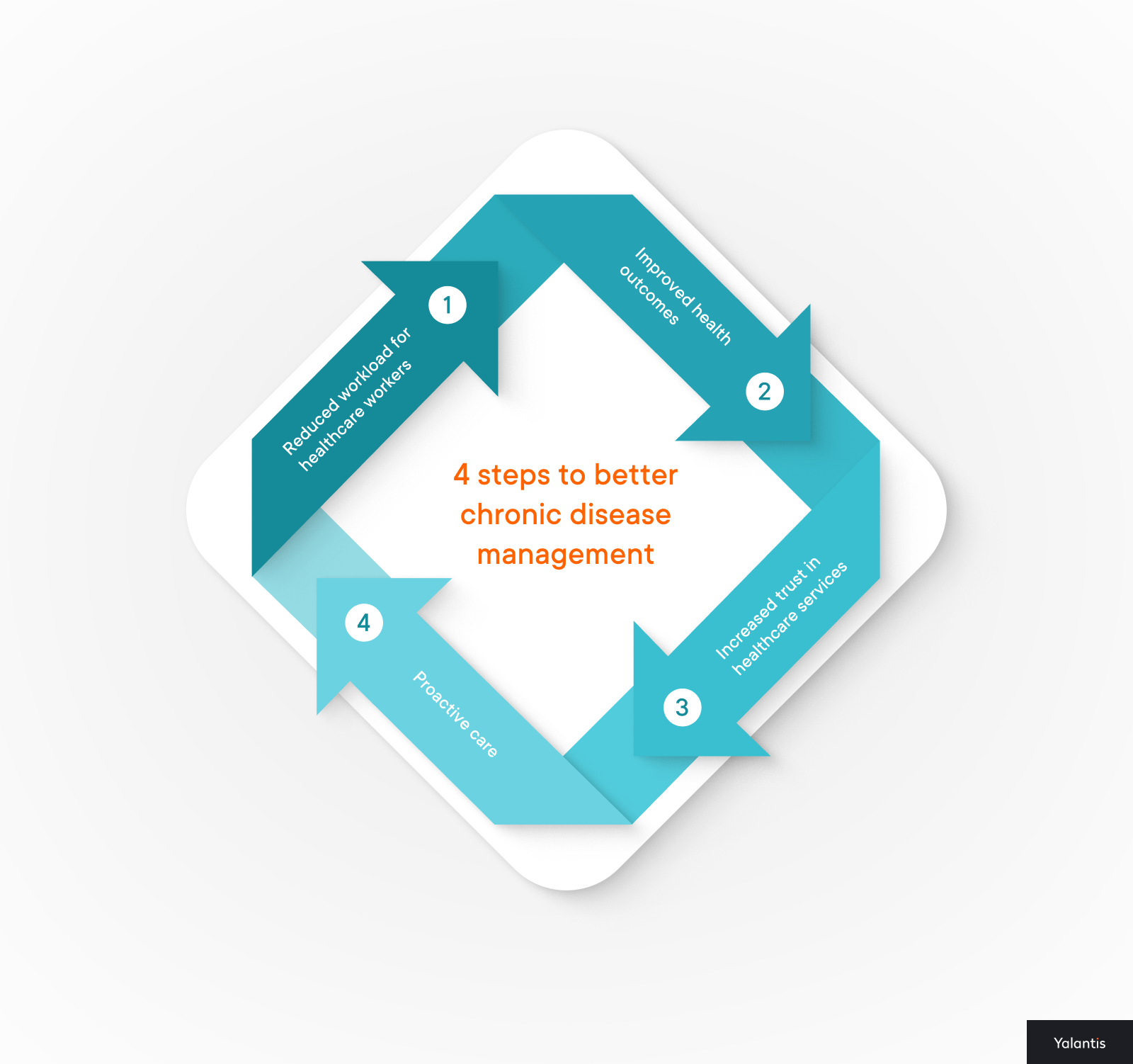
Step 1. Reduced workload for healthcare practitioners. IoT technology can shorten the time a medical worker spends gathering information on chronic disease patients by automatically measuring and sharing a patient’s vitals. Thus, a GP has more time for personalized treatment planning. Integrating medical IoT devices with healthcare systems also unburdens a healthcare worker from manually entering patient health information.
Step 2. Improved health outcomes. Chronic illness is a long-lasting condition that requires intensive chronic disease monitoring and management to avoid critical situations and hospitalization. Keeping track of symptoms is a crucial aspect of chronic disease management and using IoT is extremely helpful. IoT can be an effective solution for the detection of altering patient’s vitals, assisting in treatment, and informing a GP about a patient’s current state.
Step 3. Increased trust in healthcare services. Providing chronic disease patients with IoT devices for health management convinces them that your intention is to ensure they get every possibility for improving their health. If patients realize that they have more control over their health with the help of IoT, their trust in health care professionals grows.
Step 4. Proactive care. With the help of medical and non-medical devices that transmit data in real time, healthcare organizations can notice potential health issues early on and ensure timely intervention. For instance, a smart inhaler that notifies a GP how frequently their asthma patient uses it can indicate that some change in treatment is necessary if the frequency of inhaler usage significantly increases. The patient may not even notice this change or not pay attention but the healthcare worker has an analytics dashboard that shows the change and prompts them to take immediate action.
Consider this example of healthcare services digitalization with the help of IoT. The PreCare clinic in Denmark is the first digital clinic that provides chronic disease patients with comprehensive digital healthcare services. Each patient receives a tablet and measuring equipment to monitor their health in real time and provide all the health data directly to the clinic’s internal patient monitoring system. As a result of this approach, the Danish clinic achieved the following for their patients with chronic obstructive pulmonary disease (COPD):
- 33% reduction in acute care contacts
- 50% reduction in hospital days
- a significant slowdown in chronic disease progression
Read on to discover how to build a comprehensive IoT chronic care management system that can make all of the steps above your reality.
IoT chronic disease management system and its constituents
A single patient with a chronic disease can use several IoT medical and non-medical devices to track their health, especially if they have multimorbidity. It’s crucial to gather information from all the devices simultaneously. Therefore, we need to build a single IoT network that transmits data from all the devices at the same time to a single storage. Such an enhanced connectivity allows for holistic monitoring of a patient with chronic disease.

Below are four important constituents of a comprehensive IoT chronic disease management system.
Device layer
Connected healthcare devices, such as wearables, smart medical devices, home-based patient monitoring tools, and medical alert systems gather specific health data depending on the patient’s chronic condition. These devices can provide:
- Episodic monitoring of patients with low-risk chronic conditions
- Continuous real-time monitoring of patients with severe chronic conditions
- Alarm monitoring which immediately notifies the urgent care clinic if an emergency happens
User interface layer
Patients, clinicians, and patients’ relatives can access the data collected by IoT devices through targeted interfaces, using mobile apps, dashboards, and web portals.
- A patient-oriented interface allows them to track their health metrics, receive reminders for taking medications, and communicate with their healthcare providers.
- For health care professionals, the interface provides easy access to patient data, enabling efficient monitoring, diagnostics, and treatment adjustments.
- The patient’s family can also view the patient’s vitals, communicate with the patient and their doctor, and receive reports on the patient’s treatment and disease progress.
Cloud or storage layer
The cloud service (AWS, Microsoft Azure, Google Cloud) plays a crucial role in securely storing and processing the massive amounts of patient information generated by IoT devices. Cloud-based IoT solutions offer enhanced scalability, real-time data access, and capabilities to analyze patient data. Healthcare providers can access patient information from anywhere, enabling more collaborative and data-driven chronic disease management.
Integration layer
To maximize the use of an IoT chronic disease management system, it’s crucial to integrate it with healthcare software systems, such as patient monitoring systems, EHR, HIS, or any other. System interoperability ensures that patient data collected by IoT devices is seamlessly integrated into their existing medical history. Healthcare practitioners can view comprehensive records and make informed treatment decisions without the need for manual data entry. A data engineering company can help ensure that the integration is efficient, secure, and scalable, enabling smooth data flow between various systems for better decision-making and patient care.
How we guarantee data privacy and security
To ensure patient information privacy and security at every layer of the IoT chronic disease management system, our development, QA, and security professionals follow these practices:
- Compliance with regulations. The Yalantis healthcare software development team follows strict healthcare data regulations such as HIPAA, GDPR, and HITECH, to handle patient data with the highest level of compliance and security protocols.
- IoT device authentication. To prevent malicious devices from connecting to the network, we enable complex processes of multi-factor and cryptographic IoT device authentication.
- Encryption. All patient data is encrypted both at rest and in transit, ensuring that sensitive health information remains secure from unauthorized access.
- Data anonymization. During data analysis, we can anonymize patient information to maintain privacy while still enabling you to generate healthcare insights.
- Identity and access management. We enable role-based access control (RBAC) to allow only authorized individuals to access specific patient data. Plus, we ensure identity proofing procedures for clinicians to confirm they’re authorized to view patient vitals.
- Two-factor authentication (2FA). To prevent unauthorized access even more, your system can use two-factor authentication for both healthcare providers and patients, ensuring that only verified users can access critical health data.
- Regular security audits. We conduct routine security audits and vulnerability assessments to identify potential risks and implement timely actions. This proactive approach keeps your healthcare systems secure from emerging threats.
By enabling all of the above healthcare system security controls, our IoT security services team ensures that patient data is protected at every stage, facilitating trust and confidence in both patients and clinicians when using an IoT chronic disease management system.
Wrapping up
Chronic disease management is a growing challenge that affects patients across all demographics. As a healthcare service organization, your goal is to provide equitable, high-quality care while balancing limited resources and staffing constraints. Medical IoT solutions for chronic diseases offers a cost-effective, scalable solution that enhances your current approach without the need for major overhauls.
By integrating IoT into your healthcare services, you gain real-time insights, improve patient outcomes, and reduce the burden on your staff. It empowers you to deliver personalized care to a larger number of patients, even in rural or underserved areas, all while maintaining operational efficiency. Most importantly, IoT enables you to adopt a proactive approach to managing chronic diseases, opening the door to a future where healthcare is smarter, more accessible, and more impactful.
Ready to build a custom IoT chronic disease management system to provide better care for patients and unburden healthcare professionals?
Contact our IoT teamFAQ
How can chronic disease patients benefit from using IoT?
In multiple ways, from health metrics monitoring to even treatment, for instance, treatment of people with diabetes with the help of the smart automatic insulin delivery system. Apart from this, patients with these diseases can share vitals and communicate with their GP online without the need for leaving their home which is often preferable for patients with high-risk and severe chronic conditions.
What’s your approach to developing IoT in chronic disease management systems?
When building such systems, Yalantis prioritizes security and patient data privacy. Our development team sets up all the industry-standard security controls that ensure your IoT software is safe to use and integrate with your internal healthcare infrastructure. From the functional perspective, we take into account your target users’ needs and adjust the feature set and UI/UX accordingly.
How do you help with the selection of medical IoT devices?
Our research and development team with in-depth experience in IoT medical devices analyzes the market, your competitors, preferences, and your patients’ needs. We look for standardized and industry-proven solutions. However, if we don’t find a suitable option, we can develop a hardware medical device prototype to satisfy your every need.
Rate this article
4.9/5.0
based on 17 reviews





